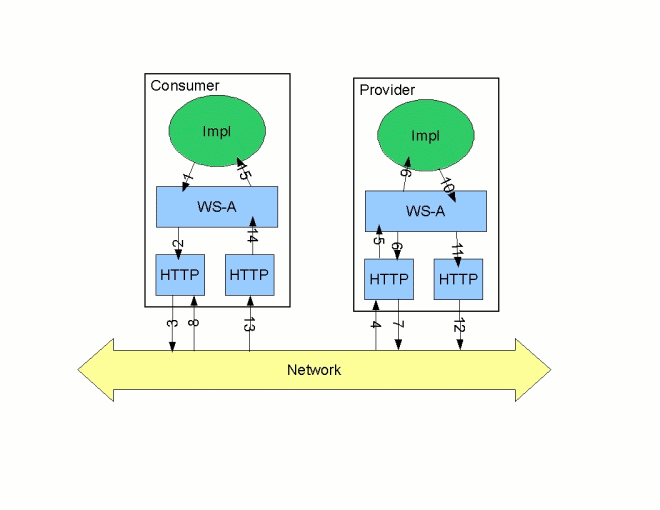Fuse 6 is no longer supported
As of February 2025, Red Hat Fuse 6 is no longer supported. If you are using Fuse 6, please upgrade to Red Hat build of Apache Camel.Ce contenu n'est pas disponible dans la langue sélectionnée.
12.6. Using the HTTP Transport in Decoupled Mode
Overview
200.
202 Accepted response to the consumer over the back-channel of the HTTP connection on which the request was received. It then processes the request and sends the response back to the consumer using a new decoupled server->client HTTP connection. The consumer runtime receives the incoming response and correlates it with the appropriate request before returning to the application code.
Configuring decoupled interactions
- Configure the consumer to use WS-Addressing.
- Configure the consumer to use a decoupled endpoint.
- Configure any service providers that the consumer interacts with to use WS-Addressing.
Configuring an endpoint to use WS-Addressing
- Adding the
wswa:UsingAddressingelement to the endpoint's WSDLportelement as shown in Example 12.18, “Activating WS-Addressing using WSDL”.Example 12.18. Activating WS-Addressing using WSDL
Copy to Clipboard Copied! Toggle word wrap Toggle overflow - Adding the WS-Addressing policy to the endpoint's WSDL
portelement as shown in Example 12.19, “Activating WS-Addressing using a Policy”.Example 12.19. Activating WS-Addressing using a Policy
Copy to Clipboard Copied! Toggle word wrap Toggle overflow
wswa:UsingAddressing WSDL element.
Configuring the consumer
DecoupledEndpoint attribute of the http-conf:conduit element.
Example 12.20. Configuring a Consumer to Use a Decoupled HTTP Endpoint
How messages are processed
Figure 12.1. Message Flow in for a Decoupled HTTP Transport
- The consumer implementation invokes an operation and a request message is generated.
- The WS-Addressing layer adds the WS-A headers to the message.When a decoupled endpoint is specified in the consumer's configuration, the address of the decoupled endpoint is placed in the WS-A ReplyTo header.
- The message is sent to the service provider.
- The service provider receives the message.
- The request message from the consumer is dispatched to the provider's WS-A layer.
- Because the WS-A ReplyTo header is not set to anonymous, the provider sends back a message with the HTTP status code set to
202, acknowledging that the request has been received. - The HTTP layer sends a
202 Acceptedmessage back to the consumer using the original connection's back-channel. - The consumer receives the
202 Acceptedreply on the back-channel of the HTTP connection used to send the original message.When the consumer receives the202 Acceptedreply, the HTTP connection closes. - The request is passed to the service provider's implementation where the request is processed.
- When the response is ready, it is dispatched to the WS-A layer.
- The WS-A layer adds the WS-Addressing headers to the response message.
- The HTTP transport sends the response to the consumer's decoupled endpoint.
- The consumer's decoupled endpoint receives the response from the service provider.
- The response is dispatched to the consumer's WS-A layer where it is correlated to the proper request using the WS-A RelatesTo header.
- The correlated response is returned to the client implementation and the invoking call is unblocked.
